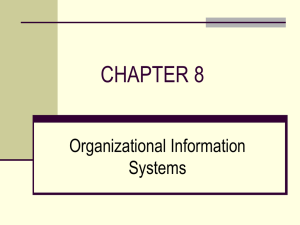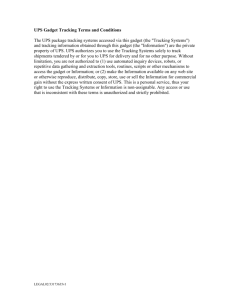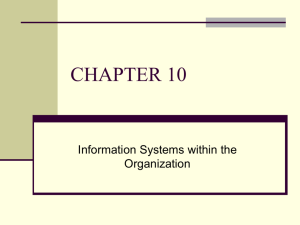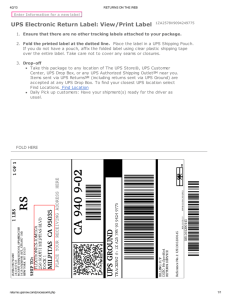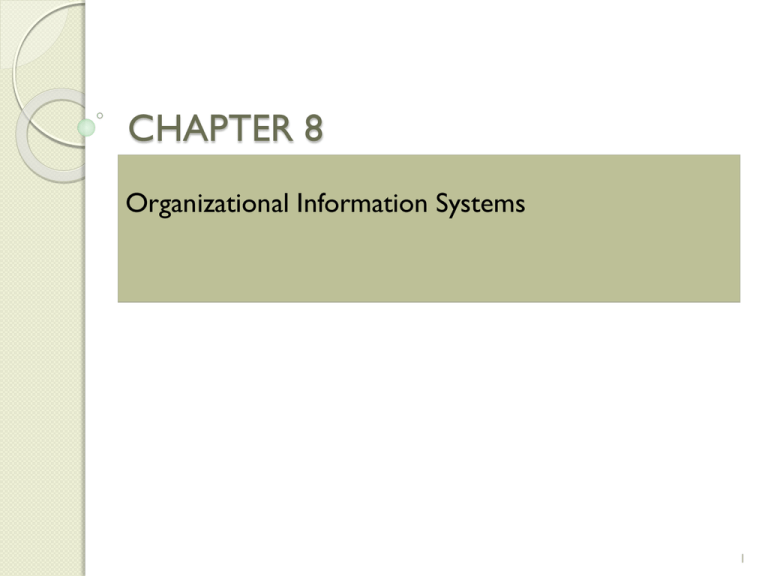
CHAPTER 8
Organizational Information Systems
1
Opening Case
THE BREADTH OF INFORMATION
TECHNOLOGY APPLICATIONS AT UPS
Founded in 1907 as a messenger company in the U.S. UPS has grown into a
$45-billion corporation by focusing on the goal of enabling commerce
around the globe.
The Business Problem
Of course, UPS is not impervious to recessions. As of mid-2010, the entire
express shipping industry, including UPS, was experiencing the effects of the
economic downturn. Despite its problems, however, UPS plans not only to
survive the difficult times but to emerge from them in better shape than its
competitors. In fact, the company is positioning itself for rapid growth as the
economy improves. To achieve this vision, UPS is adhering to its long-term
commitment to information technology investments.
2
Opening Case
Discussion
Take a look at the UPS website at www.ups.com. What types of
information systems does UPS use with its customers?
What are some additional information systems that the company
could use?
What type of security should UPS have over its systems?
Why is security and privacy important for a company like UPS?
3
Opening Case
What we learned from this case?
The opening case illustrates many of the information systems that we
discuss in detail in this chapter and introduced in Chapter 2.
UPS continues to develop information systems to support its global
operations. In fact, UPS has implemented many different
information systems and integrated them successfully, with
outstanding corporate results.
4
Agenda
8.1 Transaction Processing Systems
8.2 Functional Area Information Systems
8.2.1 Definition
8.2.2 Information systems for specific functional areas
8.2.3 Functional area information systems reports
8.3 Enterprise Resource Planning Systems
8.3.1 Definition
8.3.2 Benefits and limitation of ERP
8.3.3 Enterprise application integration
5
CHAPTER OVERVIEW
6
LEARNING OBJECTIVES
1.
Describe transaction processing systems. (8.1)
2.
Describe functional area information systems and the support
they provide for each functional area of the organization.(8.2)
3.
Describe enterprise resource planning systems, their benefits,
and limitations.(8.3)
7
8.1 Transaction Processing Systems
8.1.1 Transaction processing system (TPS)
8.1.2 Batch Processing
8.1.3 Real-time transaction processing (Online Transaction
Processing)
8
Transaction processing system (TPS) monitors, collects,
stores and processes data generated from all business transactions.
Batch Processing is when the firm collects data from
transactions as they occur, placing them in groups or batches, then
prepares and processes the batches periodically (say, every night).
Real-time transaction processing (online transaction
processing is when business transactions are processed online as
soon as they occur.
9
How Transaction Processing Systems Manage Data
10
8.2 Functional Area Information Systems
8.2.1 Definition
8.2.2 Information systems for specific functional areas
8.2.3 Functional area information systems reports
11
8.2.1 Definition
Functional area information systems (FAISs) provide
information primarily to lower- and middle-level
managers in the various functional areas. Managers use
this information to help plan, organize, and control
operations.
12
8.2.2 Information systems for specific
functional areas
The support that management information systems
provide for functional areas include:
◦
◦
◦
◦
◦
Accounting
Finance
Human Resources Management
Operations (POM)
Marketing
13
Examples of Information Systems
Supporting the Functional Areas
14
Information Systems for Accounting and Finance
Financial and Economic Forecasting. Knowledge about the availability
and cost of money is a key ingredient for successful financial planning. Cash
flow projections are particularly important, because they tell organizations
what funds they need and when, and how they will acquire them.
Budgeting. An essential part of the accounting/finance function is the
annual budget, which allocates the organization’s financial resources among
participants and activities. The budget allows management to distribute
resources in the way that best supports the organization’s mission and
goals.
15
Investment Management: Organizations invest large
amounts of money in shares, bonds, real estate, and
other assets. Managing these investments is a complex
task. To monitor, interpret, and analyze the huge
amounts of on-line financial data, financial analysts
employ two major types of IT tools: (1) Internet search
engines and (2) business intelligence and decision
support software.
16
Information Systems for Marketing
It is impossible to overestimate the importance of customers to any
organization. Therefore, any successful organization must
understand its customers’ needs and wants, and then develop its
marketing and advertising strategies around them.
Information systems provide numerous types of support to the
marketing function. In fact, customer-centric organizations are so
important that we devote Chapter 9 (Customer Relationship
Management) to this topic.
17
Information Systems for Production/Operations
Management
The production and operations management (POM) function in an
organization is responsible for the processes that transform inputs
into useful outputs and for the operation of the business. Because of
the breadth and variety of POM functions, we present only four here:
1.
in-house logistics and materials management
2.
planning production and operation
3.
computer-integrated manufacturing (CIM)
4.
product life cycle management (PLM)
18
In-House Logistics and Materials Management
Logistics management deals with ordering, purchasing, inbound
logistics (receiving), and outbound logistics (shipping) activities.
Related activities include inventory management and quality
control.
Inventory management determines how much inventory to keep
available for manufacturing or for sale to customers.
Quality-control systems used by manufacturing units provide
information about the quality of incoming material and parts, as
well as the quality of in-process semi-finished products and final
finished products.
19
Planning Production and Operations
In many firms, POM planning is supported by IT. POM planning has
evolved from material requirements planning (MRP), to
manufacturing resource planning (MRP II), to enterprise resource
planning (ERP).
The planning process that integrates production, purchasing, and
inventory management of interdependent items is called material
requirements planning (MRP).
MRP deals only with production scheduling and inventories. More
complex planning also involves allocating related resources (e.g.,
money and labour). In such a case, more complex, integrated
software, called manufacturing resource planning (MRP II)
20
Computer-Integrated Manufacturing
Computer-integrated manufacturing (CIM; also called digital
manufacturing) is an approach that integrates various automated
factory systems. CIM has three basic goals:
1. to simplify manufacturing technologies and techniques,
2. to automate as many of the manufacturing processes as
possible, and
3. to integrate and coordinate design, manufacturing, and related
functions via computer systems.
21
Product Life Cycle Management
Product life cycle management (PLM) is a business strategy that
enables manufacturers to share product-related data to support
product design and development and supply chain operations.
22
Information Systems for Human Resource
Management
Organizations today are now using IT to perform some key HR
functions: recruitment, HR maintenance and development, Payroll,
Employee Benefit Administration and HR planning and
management?
23
8.2.3 Functional area information systems
reports
Routine reports
Ad hoc (on demand) reports
◦ Drill-down reports
◦ Key-indicator reports
◦ Comparative reports
Exception reports
24
Functional area information systems generate a wide variety
of reports.
Summary reports provide summarized information, with less
detail.
Drill-down report allows users to click on an item in a report and
be able to access underlying details about that item.
Key indicator report summarizes the performance of critical
activities.
Exception reports include only information that falls outside
certain threshold standards.
25
8.3 Enterprise Resource Planning Systems
8.3.1 Definition
8.3.2 Benefits and limitation of ERP
8.3.3 Enterprise application integration
26
8.3.1 Definition
Enterprise Resource Planning (ERP) systems integrate the
planning, management and use of all resources of the organization.
That is, ERP systems are designed to break down the information
silos of an organization.
The major objective of ERP systems is to tightly integrate the
functional areas of the organization and to enable seamless
information flows across the functional areas.
A business process is a set of related steps or procedures
designed to produce a specific outcome.
27
SAP Modules
28
SAP is moving away from describing their system as a set of
modules, and now is using the term “solutions.”
On their Website, SAP has structured their Solutions tab as follows:
Financials
Human Resources
Customer Relationship Management
Supplier Relationship Management
Product Lifecycle Management
Supply Chain Management
Business Intelligence
29
8.3.2 Benefits and limitation of ERP
The major benefits fall into the following categories:
Organizational flexibility and agility
Decision support
Quality and efficiency
Decreased costs
30
Limitation
Companies may need to change existing business
processes to fit the predefined business processes of
the software
ERP systems can be extremely complex, expensive, and
time consuming to implement.
The costs and risks of failure in implementing a new
ERP system are substantial
31
8.3.3 Enterprise Application Integration
An Enterprise Application Integration (EAI) system
integrates existing systems by providing layers of
software that connect applications together.
The EAI system enables existing applications to
communicate and share data, thereby enabling
organizations to use existing applications while
eliminating many of the problems caused by isolated
information systems.
32
Closing Case
THE NO-FLY ZONE
In the weeks following the attacks of September 11, 2001, the U.S.
government sought ways to increase the amount of intelligence
data accessible to all agents and key agencies in the form of
meaningful reports.
The Business Problem
For example, in a now-famous memo from an FBI field office in
Phoenix, Arizona, an agent reported suspicions about Middle
Eastern men training in Arizona flight schools prior to September
2001. Unfortunately, the agent’s superiors never acted on this
information. These men turned out to be among the 9/11
hijackers.
33
Closing Case
Discussion
Is the watch list program a success or a failure? Support your
answer.
Are the problems with the watch list the result of technology? If
so, how? If not, what is the cause of the problems with the watch
list? Support your answer.
34
Closing Case
The Results
James Robinson is a retired Air National Guard brigadier general and
a commercial pilot for a major airline. However, he has trouble even
getting to his plane because his name is on the government’s terrorist
watch list. He must go to the ticket counter and have an agent verify
that he is James Robinson, the pilot, and not James Robinson, the
terrorist.
More than 30,000 airline passengers who have been misidentified in
the United States have asked the TSA to have their names cleared
from the watch list. Unfortunately, the number of requests to TRIP is
more than 2,000 names per month. That number is so high that the
DHS has been unable to meet its goal of resolving cases in 30 days.
35
Copyright
Copyright © 2011 John Wiley & Sons Canada, Ltd. All rights reserved.
Reproduction or translation of this work beyond that permitted by
Access Copyright (the Canadian copyright licensing agency) is unlawful.
Requests for further information should be addressed to the
Permissions Department, John Wiley & Sons Canada, Ltd. The purchaser
may make back-up copies for his or her own use only and not for
distribution or resale. The author and the publisher assume no
responsibility for errors, omissions, or damages caused by the use of
these files or programs or from the use of the information contained
herein.
36


